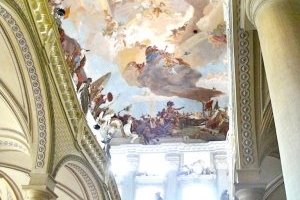
I visited this palace in August 2011. Obviously it was forbidden to take pictures since I have only one picture of the famous staircase. While this residence does not rival other European palaces in size it is remarkable in several ways: it was built by a prince-bishop who was the sovereign over a small country. It was built by the greatest artists of the Rococo among them Balthasar Neumann and Tiepolo and it contains three of the most beautiful palatial rooms I have ever seen, in taste and refinement hardly rivaled by its greatest competitors. While baroque style often overwhelms me by its weight this rococo palace seems light and airy.
When you walk up to the Beletage you pass the enormous staircase with the largest fresco in the world painted by the Tiepolo. It is a over-the-top apotheosis of the bishop and each side of the ceiling shows one of the four then known continents. It is very entertaining to study them and see what was considered typical for each continents at the time. It is full of exotic animals and shows even native Americans who practice cannibalism! If I remember correctly our guide said that the four continents should signify the "global" power and influence of the prince-bishop. The latter is also protrayed and with him Tiepolo, Neumann and other artists. The first room on the second floor is the "White Room" which is quite monochromatic and all over decorated by stucco by Antonio Bossi, a real genius, till then unkown to me. While generally stucco is for my quickly over-the-top, this is highly original and tasteful. He built this room in an extremely short time for a visit of emperess Maria-Theresia. Supposedly she didn't even look up and soon after that the artist turned crazy. The next room, the "Kaisersaal" is richer and more colourful but equally amazing: It is quite bright through the additional typical rococo round windows under the ceiling. It is full of paintings and statues glorifying the history of the prince-bishops, much of it by Tiepolo and Bossi. What I found most fascinating is how they connected painting, statues and decoration. Sometimes you have putti sitting on a cornice and it takes you a while to figure out that the upper body is painted on the wall but the legs are sculpted. Here you can easily spend half an hour or more if you are interested in the history represented and the art applied. The rest of the palace contains many more splendid rooms including the original oval room on the ground floor and the mirror room but none stuck in my memory like the three above.
When we were there the church interior was completely covered by renovation work. Judging from pictures it offers another fascinating mixture of sumptuous decoration with spacial elegance. We didn't see the gardens probably for time reasons. I would love to go back and re-examine my impression and see the missed parts. If you are in Würzburg and have time and palace capacity there is a few kilometers northwest of Würzburg the summer residence of the prince-bishops in Veitshöchheim. While the palace is much simpler then the Würzburg residence the garden is quite fanciful with fountains, statues of strange animals, grottos and ruins and conserved is in its original state. I wonder if they ever considered including this into the Würzburg application.
More on
Comments
No comments yet.
